Spaghetti with tomato sauce are the dream of Italian cuisine, a magic mix of ingredients, wisdom and history that a very few other dishes in the world have. Unfortunately this dish is manipulated, tormented and crucified almost everywhere.
–Rosario Scarpato, Honorary President Itchefs-GVCI
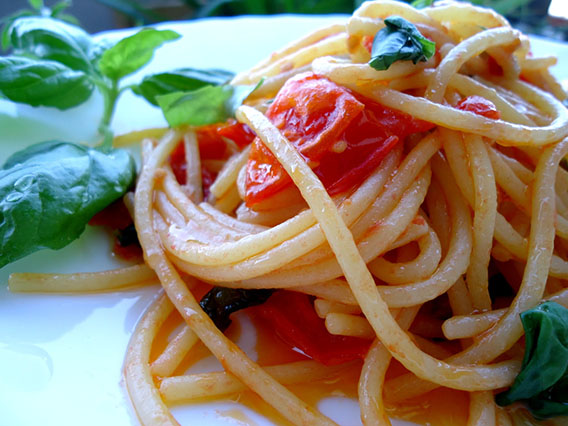
The Official Dish for International Day of Italian Cuisines, 2014, Spaghetti al pomodoro con basilico.
Credit: idic.itchefs-gvci.com
Once every year, Rosario Scarpato, Neapolitan-born gastronome, writer, film maker/director, and commander-in-chief of ItChefs-GVCI (Virtual Organization of Italian Chefs) makes a global appeal for the preservation of authentic Italian food by live video conference from the amphitheater of the International Culinary Center (ICC) in New York City, reaching 2,000 Italian chefs in 70 countries. “People all over the world are cooking Italian cuisine and yet they are not cooking Italian cuisine,” he says. “Today,” he implores,”the future of Italian cuisine is with the people in this room,” referring to the phalanx of chefs who are his followers and all who will hear him.

Rosario Scarpato, impassioned advocate for the preservation of traditional Italian food, and mastermind of the International Day of Italian Cuisine at ICC in New York.
Credit: Julia della Croce
The International Day of Italian Cuisine (IDIC) always takes place on January 17, says Rosario, because it’s the feast day Saint Anthony Abbate (Anthony the Abbot), patron saint of butchers, farmers, gravediggers, small animals, and basket makers. It is also the first day of carnevale, one day out of 365 when, according to ancient custom, licit insanire, “anything goes.” The IDIC dish of 2014 is spaghetti al pomodoro con basilico, “Spaghetti with Tomato Sauce and Basil,” probably one of the world’s most beloved of all Italian dishes–and one of the most misunderstood.

Revelers eating spaghetti at a Roman carnival, by Bartolomeo Pinelli, 1821. From Pasta Classica, by Julia della Croce (Chronicle Books). Courtesy, Eva Agnesi, original Agnesi Pasta Collection
Accordingly, the maccheroni mayhem began. A trio of three acclaimed Italian chefs, Matteo Bergamini (SD26 in NYC), Enrico Bartolini (Michelin-starred Master Chef, Devero Ristorante, Milano), and Luca Signoretti (Roberto’s Restaurant, Dubai) demonstrated the proper ingredients and preparation of the dish from the amphitheater, a performance that was broadcast worldwide. While the chefs were not allowed to deviate from the official recipe, each could use their own signature “tricks” to make the sauce and cook the spaghetti. At the same time, armed with pots, colanders, spoons, and saucepans, the virtual troops descended upon their patrons in restaurants and home kitchens from Thailand to London, Hong Kong and Dubai, to serve up the true version according to the IDIC official recipe.
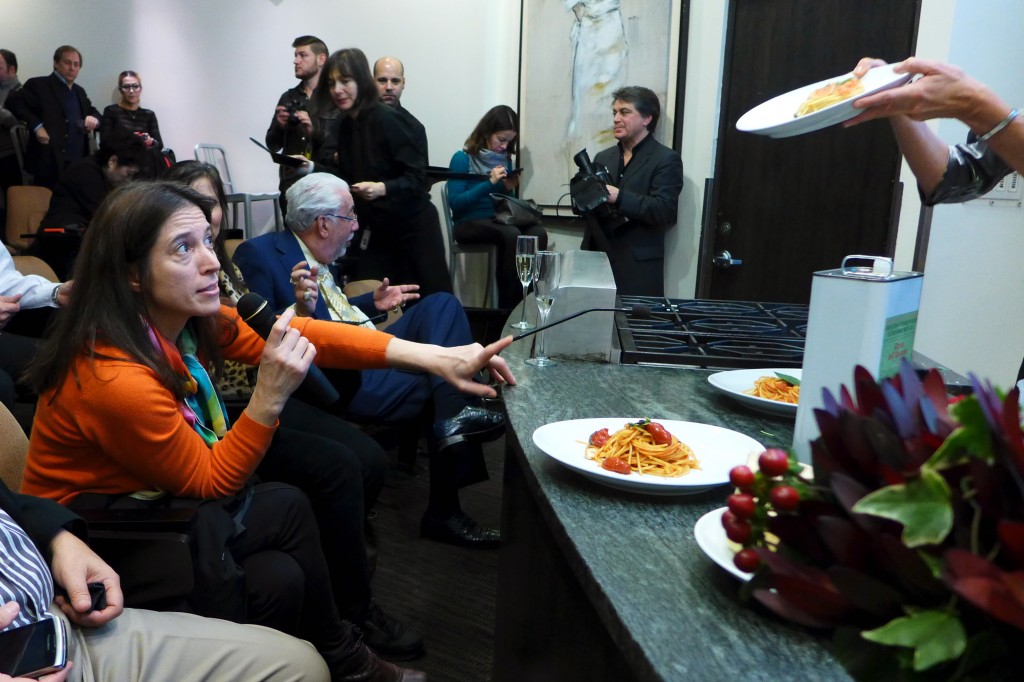
Odette Fada, former San Domenico (NYC) chef, asks the trio what their position is on adding oil to the cooking water, just for the record. Their answer, in unison, a resounding “No!”
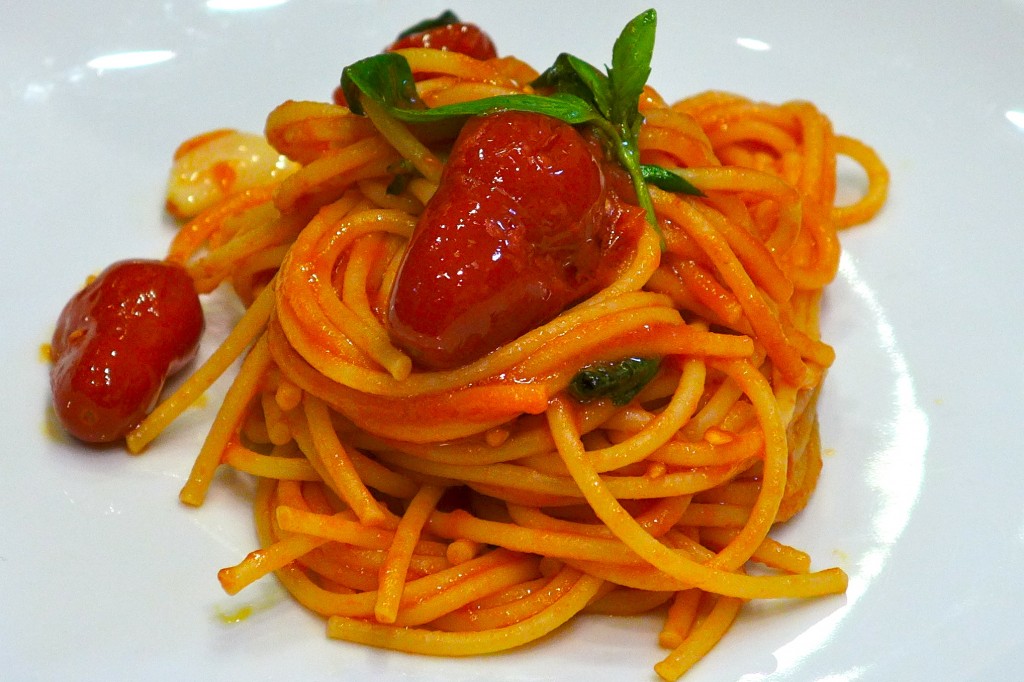
Chef Luca’s spaghetti al pomodoro con basilico with dattterini (“little dates” after their shape) would make you realize you might have never tasted the real spaghetti al pomodoro con basilico before.
Besides spaghetti al pomodoro con basilico, the dishes that have so far been studied, dissected, celebrated, and commemorated at the International Day of Italian Cuisines are, spaghetti alla carbonara (2008), risotto alla milanese (2009), tagliatelle al ragù bolognese (2010), pesto alla genovese (2011), ossobuco in gremolata alla milanese (2012), tiramisù (2013). If you are one of those people who just can’t figure out why the Italians are so dogmatic about these things (think Marcella Hazan) you might just change your mind once you try the real thing. And when you eat authentic spaghetti al pomodoro con basilico, it will be a revelation. “It is not only an Italian recipe, it is an Italian lifestyle,” Rosario says. “Sophia Loren, wherever she goes in the world, brings her ingredients with her and cooks [tomato sauce] in her hotel room over a burner.”
I look forward to the IDIC event every year because in the company of this crowd, I always learn something I didn’t know before–from Chef Matteo Bergamini, it was how to make a truly great, tomato sauce in two minutes (the secret is in the tomatoes). You might ask, “why worship at the alter of spaghetti with tomato sauce and basil in winter?” Because, says Chef Cesare Casella, Dean of Italian Studies at ICC, “You make the best [tomato sauce] with canned tomatoes from Italy, and you can eat it all year round.”

Good canned tomatoes make good tomato sauce. Pomodorini del vulcano and pomodorini corbarini, tomatoes from the volcanic soil of Vesuvius (Naples), and tomatoes from Corbaro.
While the New York conference was underway, Italian food and wine writer Luciano Pignaturo, alongside chefs in Pompeii (Naples), a stone’s throw from the archeological site and cradle of maccheroni culture, were on live video in the amphitheater, cooking spaghetti al pomodoro con basilico from the kitchen at the Ristorante President using different kinds of tomatoes and showing his tricks for mastering the art. It is also the region from whose mineral-rich volcanic dirt the first Italian tomato was spawned, and that produces the San Marzano varieties essential to a proper spaghetti al pomodoro con basilico.
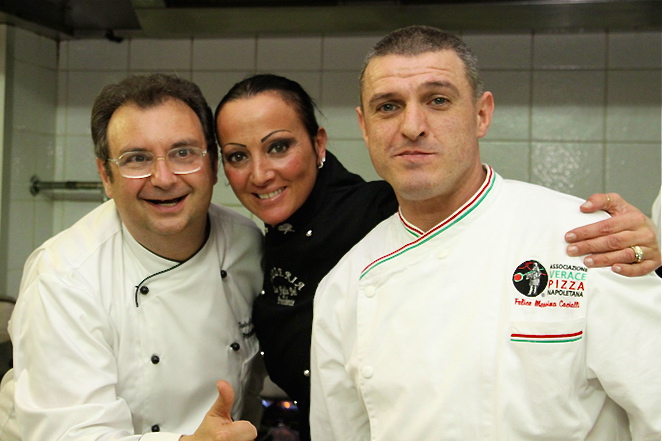
Ristorante “President” Chef-Owner Paolo Gramaglia (left) with staff.
Courtesy: Ristorante President, Pompeii (Naples)

Intensely sweet and “minerally” from the nutrients in the volcanic soil, pomodorini del Piennolo (from appendere, “to hang”), grow in the heart of the San Marzano district of Vesuvius/Naples. They’re picked in clusters and hung in bunches until ready for use, keeping throughout the winter. Credit: www.casabarone.it
Here are tips for making true spaghetti al pomodoro con basilico, straight from the mouths of three sizzling Italian chefs.
On canned tomatoes:
- San Marzano tomatoes (DOP), including Corbara tomatoes (DOP) from Vesuvius/Naples, and Piennolo tomatoes (DOP), were the favorites of all the chefs. Vesuvius’s eruption left many minerals in the surrounding soil, which produces sugary tomatoes with balancing tones of acidity that deliver powerful flavor, linked to the unique Vesuvius terroir. A particular favorite of all the chefs, Piennolo tomatoes DOP are preserved after harvesting by hanging them in ventilated rooms. Because of their characteristic thick skin, sweetness and minerality, they last throughout the winter months and as their water evaporates, their flavor is concentrated.
- Chef Luca also uses the sweet and meaty Datterini tomatoes (“baby plums”) from Sicily whose flavor some chefs think even exceeds the San Marzano varieties. He recommends using your hands to squeeze the tomatoes into the sauté pan–“it gives them something.”
Chef Matteo sautés his favorites, the Piennolo, in the olive oil for no more two minutes to “keep their clear flavor,” adding a touch of crushed chili pepper to the oil as it warms.
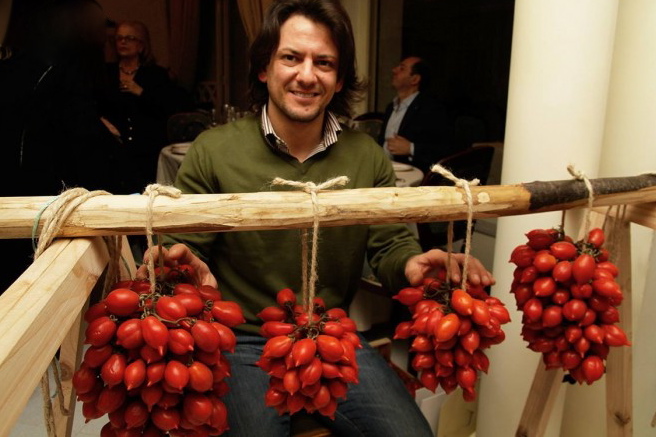
Piennolo DOP tomatoes are picked in clusters and hung for several months in the sun.
Courtesy: Ristorante “President,” Pompeii (Naples)
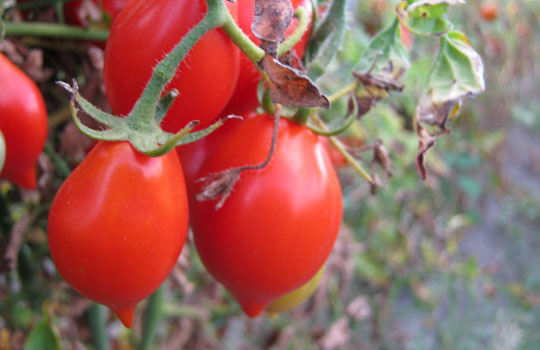
Pomodorino del Piennolo (DOP) has an intense, complex sweetness and fragrance. Credit: www.parks.it/parco.nazionale.vesuvio

Corbara pomodorini San Marzano (DOP).
Credit: www.parks.it/parco.nazionale.vesuvio
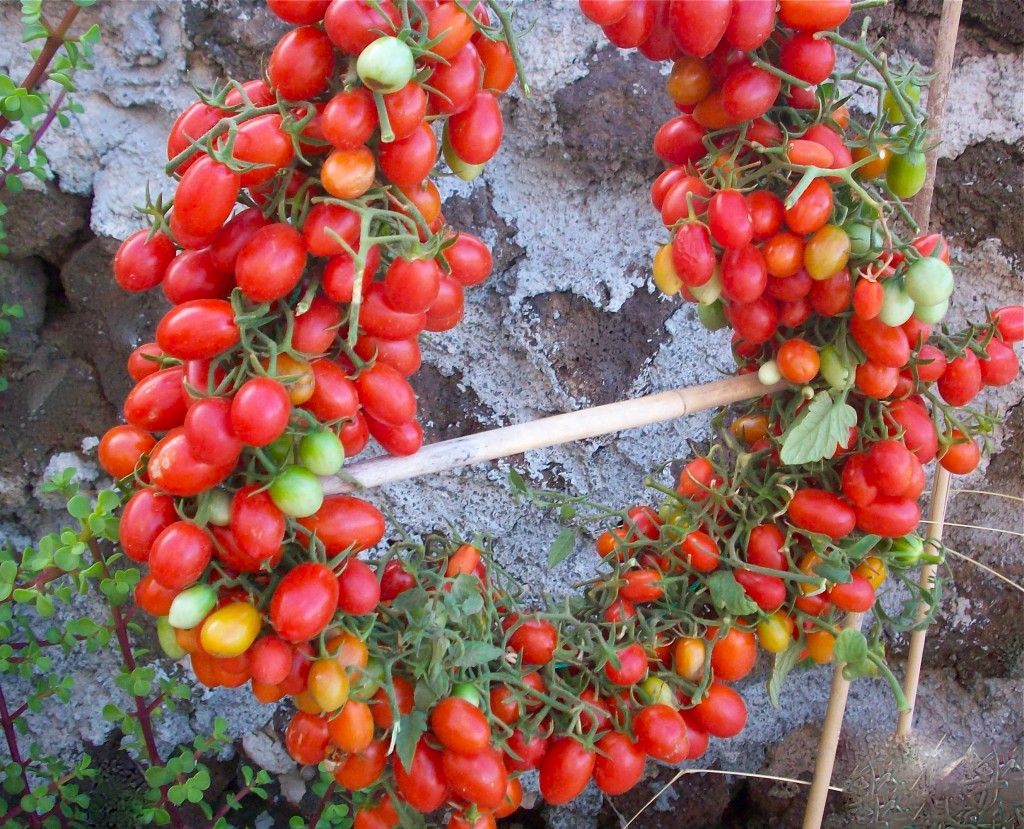
Datterini (“little dates”) pomodorini from Pantelleria (Sicily).
Credit: Piero Gaetano Catalano, Oltremare, Pantelleria
To chop or not to chop the garlic?:
- Chef Enrico chops it and warms it gently in the pan with the olive oil.
- Chef Luca and Chef Matteo used whole, bruised garlic cloves, but avoid over-cooking it–and ruining–the olive oil with too much exposure to heat in the hot skillet.
Olive oil preference:
- Do we need to say there is only one kind in Italian cooking–extra-virgin?
- All three chefs prefer Sicilian olive oil for making the sauce. Chef Matteo’s relies on Manfredi Barbera. Two out of three added a “thread” of olive oil to the sauce when it’s done.
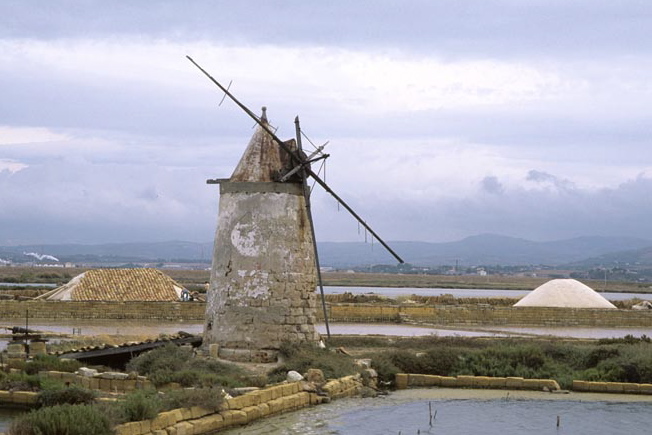
The preferred sea salt of all the chefs is Sicilian. The salt flats of Trapani.
Credit: Paolo Destefanis
About salt, it was unanimous–all the chefs were hooked on Sicilian (Trapani) sea salt.
On the matter of basil (fresh, of course):
- “You know great basil from the smell. You don’t get it from green house basil.”
- Chef Matteo only adds it at the very end, just when the sauce is done, to keep its intense flavor [intact].”
On the pasta:
- Chef Matteo uses the La Molisana brand exclusively, specifically the spaghetti alla chitarra shape for spaghetti al pomodoro–“Because [the strands] are square it takes the sauce nicely.”
- Chef Luca’s choice was De Cecco spaghetti. He cooks the pasta only half way in the water, then drains it and adds it to the sauce in the sauté pan until it finishes cooking.
- Chef Enrico adds the tomato water to the pasta cooking water for added flavor.
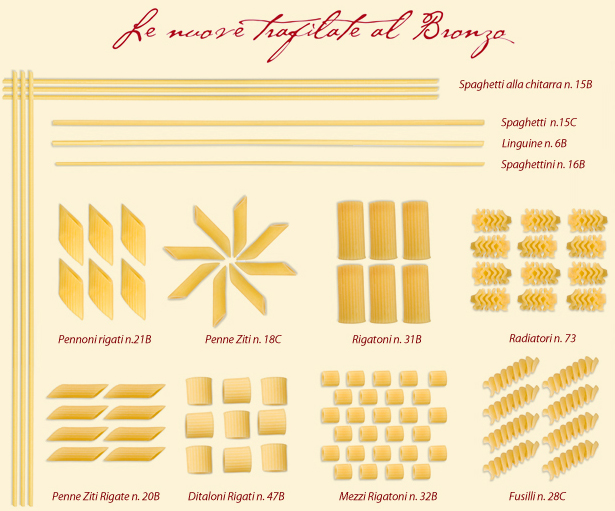
La Molisana, still extruded using bronze dies, a beloved Italian brand with a passionate following.
Credit: http://en.lamolisana.com/novità_bronzi.php
Cheese or no cheese?:
- Grana Padano DOP, made in a similar tradition to Parmigiano-Reggiano®, a popular condiment, was a sponsor of the IDIC , but not traditional for spaghetti al pomodoro con basilico.
- Chef Luca scatters a layer of freshly grated Grana Padano over the spaghetti and the sauce in the sauté pan to absorb excess tomato juices and leaves it untouched until excess water is absorbed.
- Chef Matteo never adds grated cheese because he finds it interferes with the flavor of the tomatoes. If people ask for it in the dining room, he lets them have it.
As for wine, Alessandra Rotondi, Italian wine expert and IDIC Master of Ceremonies recommended Lacryma Christi (literally “the tears of Christ) from Campania, from a grape that grows in the same Vesuvio terroire as the San Marzano tomatoes.
Source: Piennolo and Corbara tomatoes are available retail online, or wholesale through Gustiamo, exclusive importers of the Pomodoro del Piennolo DOP from the Casa Barone farm, Vesuvius district.
THE RECIPE: SPAGHETTI AL POMODORO CON BASILICO “AL DENTE”
(AL DENTE SPAGHETTI WITH TOMATO SAUCE AND BASIL)

Chef Mario Caramella´s version of this year´s recipe, adapted for American readers
Serves 4
Ingredients:
1 pound (1 package) durum wheat imported Italian spaghetti
2 28-ounce cans of Italian peeled tomatoes in natural juices (San Marzano DOP), or substitute 600 gr tomatoes from piennolo
fresh garlic cloves to taste
5 tablespoons best quality extra-virgin olive oil
sea salt to taste
several fresh, fragrant Genoa type basil leaves
Method:
- In a large pan lightly brown the fresh garlic in the extra virgin olive oil (avoid burning it or it will taste bitter and not right)
- Add the tomatoes, cook at medium heat for 8-10 minutes
- Cook the spaghetti al dente, drain them and toss in the tomato sauce for 1-2 minutes over medium heat
- Put the spaghetti in individual previously warmed plates; add some sauce, a few drops of extra virgin olive oil and a couple of fresh basil leaves on each plate
- Serve warm
You may add some grated Grana Padano DOP cheese, a rather common habit in some Italian families, but the original recipe didn’t include it.

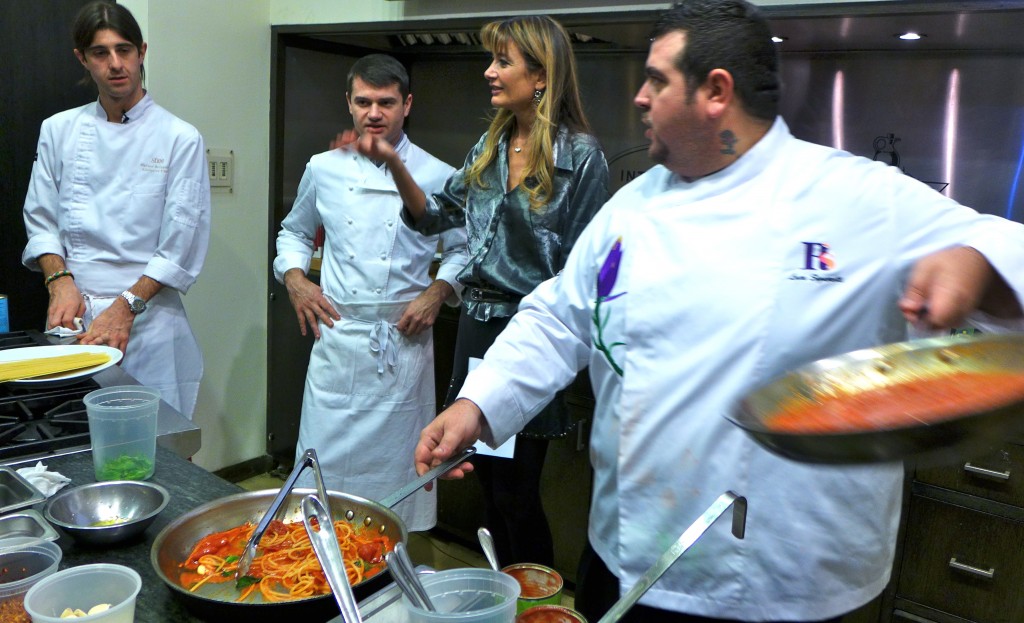
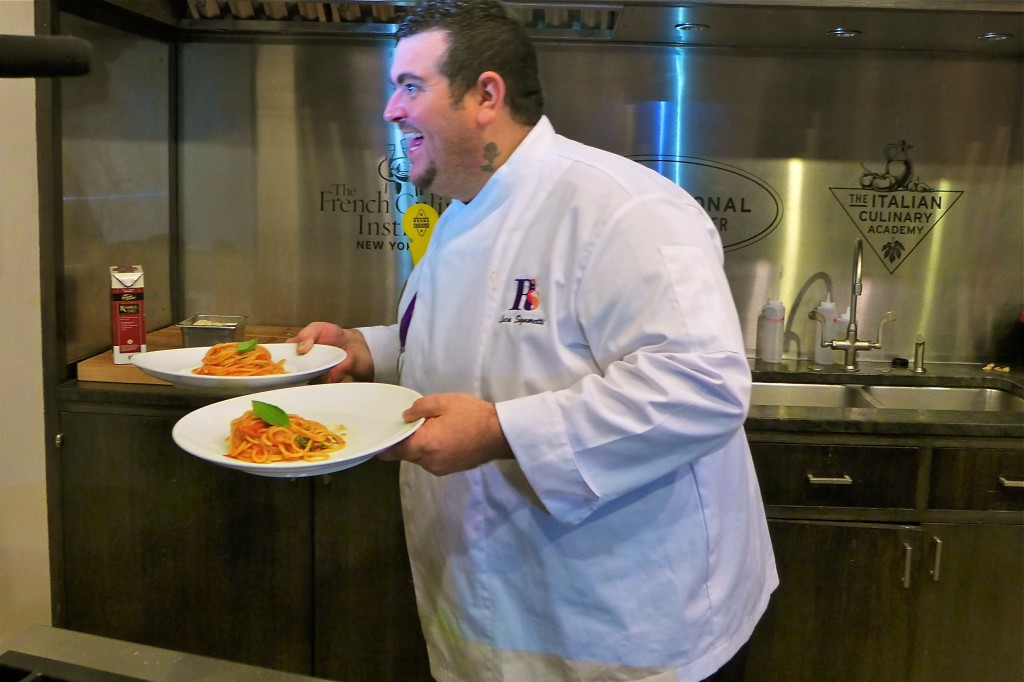

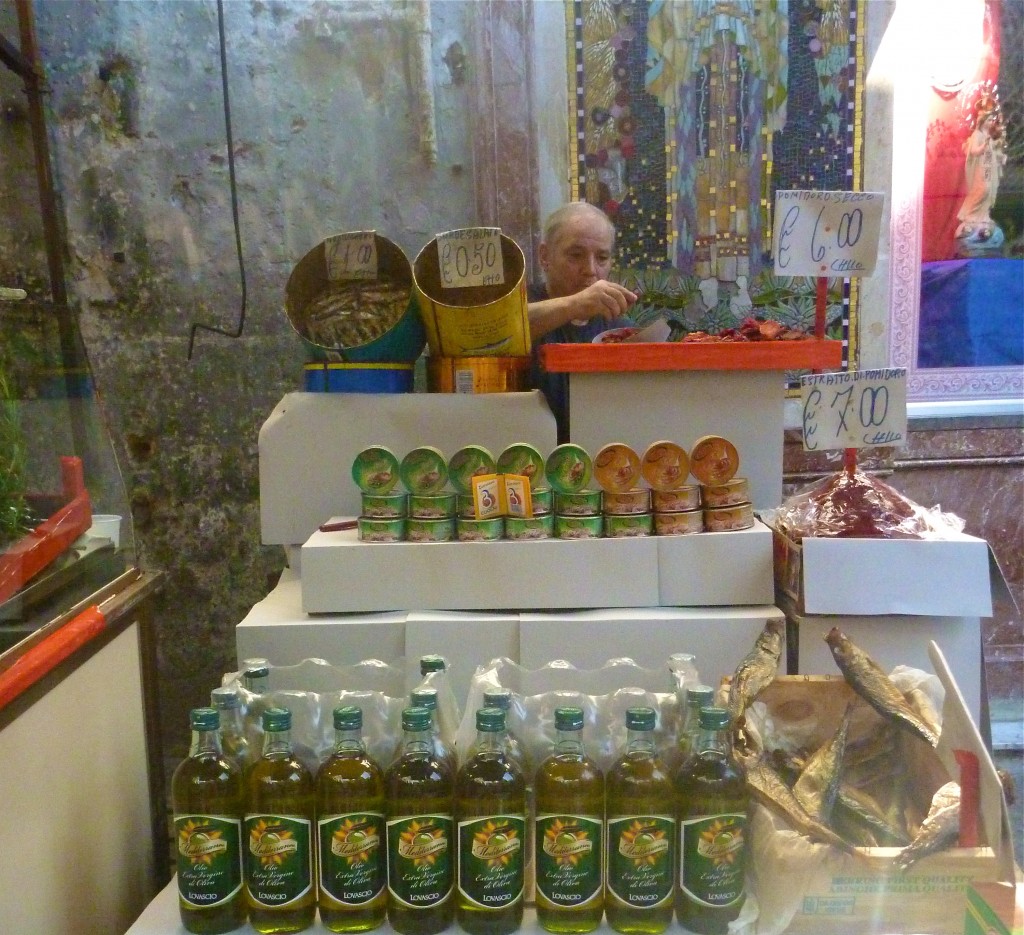
 Follow
Follow
 email
email
This is a GREAT article! As someone who must’ve been an Italian nonna in her past life, I really appreciate all the information I can get to further my Italian cuisine education.
Speaking of Thailand though, oh if you only see what my people have done with Italian food, you’d be horrified…and a little bit delighted. 😉 Thais are very resourceful and we have the gift to adapt to anything. One of the dishes I grew up with was known as “Macaroni Stir-fry” which the pasta is tossed with butter, chopped deli ham, Kraft parmesan, and, wait for it, ketchup. It’s a poor man spaghetti, really. But then in some of the restaurants, you’ll find local flavors like the spicy spaghetti and clams with Thai chili jam and Thai basil.
Terrific to have this input from the point of view of a non-native Italian. There’s been a lot of scuttlebutt about this post on social media and email, Italians saying, why bother; doesn’t everyone know how to make spaghetti with tomato sauce?! I think it was precisely this kind of interpretation outside of Italy that made the IDIC people decide to officialize the dish and give a master class. Though, as you no doubt know, there is no “official” recipe for anything in Italian cooking. Thanks for writing.
Great article! Of course, if there are rules I am going to love it! First I found the “official” ragu Bolognese (posted about it) then did some research when you did your “real spaghetti carbonara”…and no, there should not be onions, it really doesn’t work well, discovered after having it a a restaurant last week, and now this “official” tomato sauce…I love it all. Thanks a whole bunch Julia…such fun. Wish we could eat some together and of course a great wine to share!
I love when you weigh in, you always have something to add to the conversation. Here’s to our paths crossing sooner rather than later, Phyllis.
I’m a sucker for “pure recipes” and I always thought the onion thing was strange, but I tried Lidia Bastianich’s recipe which starts with sautéing an onion and then adding some chicken broth. It was delicious.
I am always elated to read articles like this, as it gives me hope. Yesterday, I was telling someone that one of the reasons that I started my blog was to try to stop authentic Italian cuisine from suffering a horrific demise here in America, and she pointed me to your article.The west coast is so much worse than the east in terms of its authentic Italian cuisine; the most authentic food I can find is in my own kitchen.
I look forward to following along!
Christina at Christina’s Cucina
Thank you, I’m so glad to have you!
What a wonderful article. The simplicity of the recipe just warms my heart and makes me hungry. It’s interesting that the Italian chefs prefer Sicilian products. Thank you.
The volcanic soil in Sicily produces tomatoes with astonishing flavor, and the same goes for their olive oil and other agricultural products. Thank you for joining the conversation.
this is truly an art
Grazie, Lynnda!
Really great article! I am really deep in the real italian cuisine now, since I started to spend a lot of money for high quality imported italian products. Also I am glad to see that my version of Pasta al Pomodoro isn´t far away from, the versions of the italian chefs. That might my to think I am on the right train ;). For my version I use Canned San Marzano Tomatoes D.O.P, Garlic, a bit of fresh Peperoncino, Sea Salt, Telly Cherry Pepper freshly grated and I add a bit of Pecorino to the Sauce and stir it under the Pasta and Sauce, also fresh Basil goes in, after cooking. I finish the dish with more grated Pecorino and good glug of high quality strong fruity olive oil from sicily.
And now I have to try Trapanese Sea Salt….
Greetz
Daniel
Glad to have another believer on board!